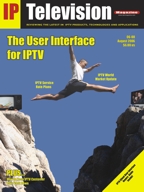|
Highly targeted and addressable advertising offers the potential to increase advertising revenue per viewer by a factor of over 20 times while the viewer experience becomes more personalized and well received. This means that targeted advertising may become the single most important reason for the rapid introduction of IPTV.
For example, according to CNN/Money, one of the highest advertising revenue sources was the average $2.4 million US paid for 30 second advertising spots ($80,000 per second) during American football super bowl 2005. Based on a worldwide viewing of the super bowl of 140 million viewers, this is a cost of approximately 2 cents per viewer. Compare this to the average cost per click on Google's paid advertising of 54 cents in 2004 (according to www.RankforSales.com) where the advertiser only pays for interested viewers.
Addressable advertising has another important benefit, increasing the satisfaction of the viewer. According to a 2004 report by Yankelovich Partners, 65 percent of consumers feel constantly bombarded with too many marketing messages and there is evidence that this resistance and negativity is growing.
One aspect of the radical change envisaged with IPTV is that TV advertising will become much more personalized. Whilst viewers are watching the same content, the ads that are played out to them can be varied according to demographics, shopping habits and personal preferences, so that advertising becomes a lot more relevant.
Viewers do not have to radically change their television-watching habits to benefit from well targeted IPTV advertising. Television viewing can still remain a 'lean-back' activity - in contrast with the more dynamic process of using a PC. However, it is likely that TV ads of the future will have little in common with those being broadcast today. For viewers, channels that come through their IPTV system (and they may not actually know it is an IPTV system) will simply provide ads that are more relevant and engaging. But behind the scenes in the media industry, there will be a seismic shift with production of creatives, pricing structures and accessibility of the ad avail all undergoing a revolution.
Currently ads that are sent through terrestrial, cable and satellite systems - whether digital or analog - are broadcast to the entire subscriber base in a region. The ads may be filtered after reaching the user's set-top box or PVR to display alternatives but these are largely governed by simple and crude demographic factors. The insertion of ads is often related to little more than the rough geographical location of the household. The scenario is definit |
 |
|
of the household. The scenario is definitely 'one size fits all' across the network with only a limited choice of advertising - and one which is determined by the preferences of advertisers and broadcasters rather than those of viewers - when it reaches its destination.
For instance, in the cable world, Comcast Spotlight has pioneered two targeted advertising services called Adcopy and Adtag. These allow different ads to be distributed to different zip code areas, with the ads being defined according to the general demographics of that region. For example, an automaker can show various vehicles from its range to different areas in a broadcast region. Or the end of an advertisement can be 'tagged' with the name and contact details of the local dealer. The limitation of this approach, however, is that the regions being targeted are still relatively large - encompassing hundreds or even thousands of subscribers.
But it doesn't have to be like that. Because of the in-built addressability of IP, IPTV ads can be targeted at large groups, small groups, or even individual television sets within a single household. Crude distinctions based on geographical location can become a thing of the past. For example, advertisers could target specific income groups; people interested in particular sports; first-time parents; or perhaps |
|
individuals who bought a particular car a certain number of years ago. The possibilities are limitless. And this is the cornerstone of true addressable advertising.
Whilst 'addressable advertising' - a term originally coined by advertisers about a decade ago - is a simple concept, delivering personalized ads to TV sets has been a lot more problematic than its parallel on the internet: where we are all becoming used to having recommendations made to us based on our interests or previous actions.
To understand how ad insertion is implemented today it is useful to look at how it is done in traditional cable networks. The ad insertion system's two core elements are the splicer and the ad server. The splicer - typically supplied by companies such as Terayon and BigBand - is a type of switch which can generate an output video stream from one or more input streams. In addition it can locate the video splice points from the digital cue tones and use them to trigger and control other devices such as an ad server. |
The ad server streams the various ads into the splicer - playing them out at the right moment, simultaneously. Typical suppliers are C-COR and SeaChange.
A typical ad insertion implementation in a cable network is shown in Figure 1. Broadcast streams from the head-end come in to the splicer and when the ad isn't being shown these are just re-transmitted as separate but identical streams to the different target groups. Embedded in the incoming streams are the digital cue tones that signal the location of the ad avails and these are detected by the splicer and passed as triggers to the ad server. At the start of the ad avail the ad server starts playing out the separate ad streams. These are then fed back into the splicer which inserts them into the outputs sent to the target groups. When the ad avail is completed, the splicer reverts back to
|
|
advertisement and so on: generally acting in a much more interactive and web-like way.
Another attribute of IPTV that is not shared to the same extent by satellite, terrestrial or cable broadcasting, and which opens up considerable opportunities for advertisers, is that the underlying IP network is inherently bidirectional.
Firstly, this means that viewer responses to advertisements can be collected - in real-time if desired - giving valuable feedback to advertisers. Because the control for changing the channels is done within the network, IPTV can provide the opportunity to monitor accurately who is watching what ads. This will allow much more accurate auditing of campaigns and a dramatic improvement over current methods of audience measurement which generally rely on imprecise methods using very small sample sizes. It also enables payment models to be geared to actual eyeballs watching rather than estimated numbers of viewers: again bringing television advertising closer to the internet where pricing based on how many people click on the ads has become commonplace.
This ability to monitor the viewer's activity and responses is also a valuable tool in maximizing campaign efficiency. An advertisement can be shown the optimum number of times - typically between three and five - and excessive showings, say of more than 30 which tend to alienate rather than engage, can be eliminated. Furthermore it enables narrative advertisements, which are delivered in sequence to tell a story, to be delivered at an appropriate pace depending on how often viewers see the ads.
Although initially narrative advertising will probably be carried out on a group basis it will undoubtedly become a more precise art as granularity heads nearer and nearer the ultimate aim of one-to-one. With that viewers could be invited to participate in what they are seeing - perhaps defining storyline preferences or selecting an alternative endings.
Even more appropriate to the high levels of personalization that are made possible by IPTV are the customized TV advertising tools being developed by Visible World. These enable advertisements to be broken down into individual elements such as different scenes and languages that can be reassembled in different ways to convey tailored messages for specific groups of viewers.
For example, an advertisement for vacations could show tranquil sunsets over the ocean, an expensive-looking hotel with relaxing background music and a sport such as golf for an older, more affluent viewer group; or feature adventure sports, a more economical hotel and the appropriate background music for a younger, less wealthy audience.
Packet Vision's dynamic IPTV ad insertion system, for instance, which enables the piecing together of elements to be carried out 'on the fly', would enable content-synthesis software to create ads that can change according to real-time situations, such as the frequency-capping scenario mentioned above, where different ads are generated for different viewers/viewer groups once it has been discovered that they have seen the ad a certain number of times. In addition, ads could be changed according to audience demographics, geographic location, |
program content, time of day, language and other variables.
But will these new forms of advertising breathe new life into the industry? Or will PVRs spell the death of TV advertising?
A study by Continental Research for Sky in the UK has shown, not surprisingly, that households with PVRs do tend to skip ads and view less than households without them. But despite this it was found that the factor of how well the message has been delivered remains largely unchanged. This reinforces something that advertisers and ad agencies have always known: that relevance is the most critical factor in generating brand recognition and driving consumers to action, with the number of times an ad is viewed being of less significance. And targeted advertising, of course, is all about relevance.
On the issue of relevance, IPTV of course opens up opportunities generally for localization and personalization extending beyond the ad avail. A recent experiment by Telekom Austria, in the village of Engerwitzdorf explored ultra-local TV by giving the villagers all the equipment needed to create their own TV channel. The Buntes Fernseh - or 'Colourful Television' - project gave the people full editorial control and studied them to see what sort of content was created and how it was received. The results found that the resultant television was of surprisingly high quality and was watched by a far larger audience than expected: again reinforcing the core principle of the importance of relevance.
Ultra-local television, therefore, may well be the stimulus that is needed for local companies to use television advertising as a promotional tool. Because IPTV enables many different ads to be delivered simultaneously within one avail, purchasing time on television need no longer be prohibitively costly for smaller businesses - and could even prove cost-effective for special interest groups or individuals. But even with this issue out of the way, there are others that need to be addressed: most of which apply whatever size company is advertising.
Firstly, advertising to specific target groups is impossible without sufficient information to locate them. Information about who is watching what programmes, what channels and when needs to be collated. By combining this data with genre information companies such as The Zap Corporation have created software that constructs basic viewer profiles. The next step is for these profiles to be refined and improved using consumer behaviour data - for example what products people buy or are interested in - that allows the advertisers to build accurate pictures of their audiences. This then can work hand-in-hand with the ongoing process of real-time TV ad monitoring to refine the relevance and placement of the ads.
Such processes, of course, are regulated and controlled, with various acts in both Europe and the US that ensure viewers' privacy is scrupulously protected. The 1984 Communications Policy Act, for instance, restricts the use of consumer data - so that user-specific information is not used except for providing the telecommunications service itself. Data that is not directly associated with a particular individual, however, can be used for various purposes including marketing and offering new services. Accordingly, ZIP codes of households could be used to refine viewer profiles, provided actual names were not revealed. |
|
Also included in the regulations - and in widespread use in marketing generally and particularly on the internet - is 'opting in'. Here, viewers allow their 'user-specific' data to be used, often for direct marketing, in return for perhaps receiving newsletters or being included in special offers.
A recent survey on internet ads by the Ponemon Institute found that 45 percent of respondents would part with personal information if it meant they would receive ads targeted to their individual interests although, not surprisingly, there were also concerns that sensitive personal data should not be misused.
It is the relevance of ads, therefore, that is the crucial issue. And this has been borne out by the popularity of a scheme piloted on HomeChoice. This allowed subscribers to view commercials on-demand, using their remote control to vote on whether they loved or hated them, and the results were used to compile an 'Ad Chart'. Up to a quarter of HomeChoice households viewed the channel each month, spending up to 13 minutes per visit, and the favorite ads were found to receive 10 times the viewership of the less popular ones.
For television advertising to thrive, therefore, the migration towards the dynamic, interactive and personal TV will be critical. But given that this requires the addressability and bi-directionality of IP, what about networks other than telco and broadband? |
It is true that cable networks as they stand
currently do not have the capabilities needed for one-to-one
targeting. But with the Next Generation Network Architecture (NGNA), however, cable companies will migrate their networks to IP and several are well progressed with their plans. Already 3G mobile networks are IP based, enabling activities such as mobile phone marketing where people receive ads with money-off coupons.
So although IPTV at the moment is very much
in the domain of limited television implementations and the internet,
we don't have to look too far into the future to envisage a world
where the delivery of television using internet protocol is
ubiquitous. Along with that there is the hope that future TV
advertising can be much more relevant and engaging to the viewer
rather than an irritation to be actively avoided. |






 Patrick Christian is founder and managing director of Packet Vision Limited, which specializes in network-based addressable IPTV advertising delivery systems. He can be contacted at patrick.christian@packetvision.com
Patrick Christian is founder and managing director of Packet Vision Limited, which specializes in network-based addressable IPTV advertising delivery systems. He can be contacted at patrick.christian@packetvision.com